
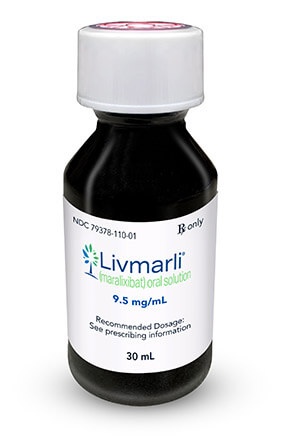
LIVMARLI 9,5 mg/mL SOLUÇÃO ORAL

Pergunte a um médico sobre a prescrição de LIVMARLI 9,5 mg/mL SOLUÇÃO ORAL

Como usar LIVMARLI 9,5 mg/mL SOLUÇÃO ORAL
Introdução
Prospecto: informação para o utilizador
Livmarli 9,5 mg/ml solução oral
maralixibato
Este medicamento está sujeito a monitorização adicional, o que facilitará a detecção de nova informação sobre a sua segurança. Pode contribuir comunicando os efeitos adversos que possa ter. A parte final da secção 4 inclui informação sobre como comunicar estes efeitos adversos.
Leia todo o prospecto atentamente antes de começar a tomar este medicamento, pois contém informação importante para si.
- Conserva este prospecto, pois pode ter que o ler novamente.
- Se tiver alguma dúvida, consulte o seu médico ou farmacêutico.
- Este medicamento foi prescrito apenas para si, e não deve dá-lo a outras pessoas, mesmo que tenham os mesmos sintomas que si, pois pode prejudicá-las.
- Se si ou seu filho experimentarem efeitos adversos, consulte o seu médico, farmacêutico ou enfermeiro, mesmo que se trate de possíveis efeitos adversos que não aparecem neste prospecto. Ver secção 4.
Conteúdo do prospecto
- O que é Livmarli e para que é utilizado
- O que necessita saber antes de si ou seu filho começarem a tomar Livmarli
- Como tomar Livmarli
- Possíveis efeitos adversos
- Conservação de Livmarli
- Conteúdo do envase e informação adicional
1. O que é Livmarli e para que é utilizado
O que é Livmarli
Livmarli contém o princípio ativo maralixibato (na forma de cloreto). Ajuda a eliminar substâncias chamadas ácidos biliares do organismo.
Os ácidos biliares encontram-se no líquido digestivo denominado bile que produz o fígado. Os ácidos biliares passam do fígado para o intestino e ajudam a digerir os alimentos. Após ajudarem à digestão, regressam ao fígado.
Para que é utilizado Livmarli
Livmarli é utilizado para tratar o prurido colestático em doentes a partir de 2 meses de idade com a síndrome de Alagille (SALG). Livmarli também é utilizado para tratar a colestase intra-hepática familiar progressiva (CIFP) em doentes a partir de 3 meses de idade.
A SALG e a CIFP são doenças genéticas raras que podem causar uma acumulação de ácidos biliares no fígado. Denomina-se colestase. A colestase pode piorar com o tempo e geralmente produz picos intensos, depósitos gordurosos debaixo da pele (xantomas), atraso do crescimento e sensação de cansaço.
Como funciona Livmarli (maralixibato)
Maralixibato actua reduzindo a acumulação de ácidos biliares no fígado. Isso é feito evitando que os ácidos biliares sejam transportados de novo para o fígado uma vez que realizaram a sua função nos intestinos. Isso permite que os ácidos biliares saiam do organismo através das fezes.
2. O que necessita saber antes de si ou seu filho começarem a tomar Livmarli
Não use Livmarli
- Se si ou seu filho são alérgicos ao maralixibato ou a algum dos outros componentes deste medicamento (incluídos na secção 6).
- Se si ou seu filho padecem de insuficiência renal e/ou hepática grave.
Advertências e precauções
Consulte o seu médico se a sua diarreia piorar enquanto estiver a tomar Livmarli. Se tiver diarreia, beba muito líquido para não desidratar.
Pode observar-se um aumento nos níveis das enzimas hepáticas nos testes funcionais hepáticos enquanto se toma Livmarli. Antes de começar a tomar Livmarli, o seu médico medirá a sua função hepática para comprovar se o seu fígado funciona corretamente. O seu médico realizará controlos periódicos para controlar a função hepática.
O seu médico pode fazer-lhe análises de sangue antes de iniciar ou durante o tratamento com Livmarli para comprovar o seu INR (índice normalizado internacional; um teste de laboratório para controlar o risco de hemorragia) e os níveis de certas vitaminas armazenadas na gordura corporal (vitamina A, D, E e K). Se os seus níveis de vitaminas forem baixos, o seu médico pode recomendar-lhe que tome vitaminas.
Algumas doenças, medicamentos ou operações podem afetar o movimento dos alimentos pelo intestino. Da mesma forma, podem afetar o movimento dos ácidos biliares entre o fígado e o intestino. Isso pode afetar o funcionamento correcto de maralixibato.
Certifique-se de que o seu médico conhece as doenças, medicamentos ou operações que teve ou tomou.
A tomada de Livmarli com medicamentos que contêm álcool pode produzir efeitos adversos nos crianças menores de 5 anos de idade ou nos doentes com redução da função do fígado e/ou do rim. Se si ou seu filho têm uma redução da função do fígado e/ou do rim ou se seu filho é menor de 5 anos de idade, consulte o seu médico ou farmacêutico antes de começar a usar este medicamento, especialmente se si ou seu filho utilizam outros medicamentos ou suplementos alimentares que contenham propilenoglicol ou álcool.
Crianças
Livmarli não é recomendado em crianças com síndrome de Alagille menores de 2 meses de idade. O motivo é que ainda se desconhece se é seguro e eficaz neste grupo etário.
Outros medicamentos e Livmarli
Informa o seu médico ou farmacêutico se está a tomar, tomou recentemente ou pode ter que tomar qualquer outro medicamento, incluindo medicamentos sem receita e à base de ervas.
Informa o seu médico se está a tomar algum dos seguintes medicamentos:
- Fluvastatina, rosuvastatina ou simvastatina (medicamentos utilizados para tratar os níveis altos de colesterol no sangue)
- Midazolam (um medicamento utilizado para a sedação ou para induzir o sono)
- Ácido ursodesoxicólico (um medicamento utilizado para tratar as doenças hepáticas)
Gravidez e amamentação
Se está grávida ou em período de amamentação, acredita que possa estar grávida ou tem intenção de engravidar, consulte o seu médico ou farmacêutico antes de utilizar este medicamento. Se está grávida, é melhor que não tome Livmarli.
Livmarli não entra na corrente sanguínea, por isso não se prevê que passe para o leite materno. No entanto, siga sempre as recomendações do seu médico.
Condução e uso de máquinas
A influência de Livmarli sobre a capacidade para conduzir e utilizar máquinas é nula ou insignificante.
Livmarli contém propilenoglicol e sódio
Este medicamento contém 364,5 mg de propilenoglicol em cada ml. Quando se toma de acordo com o esquema de administração recomendado para a SALG, a exposição ao propilenoglicol será de um máximo de 17 mg/kg/dia. Quando se toma de acordo com o esquema de administração recomendado para a CIFP, a exposição ao propilenoglicol será de um máximo de 50 mg/kg/dia.
Se seu filho é menor de 5 anos de idade, consulte o seu médico ou farmacêutico antes de começar a administrar-lhe este medicamento, especialmente se utiliza outros medicamentos que contenham propilenoglicol ou álcool. Se está grávida ou em período de amamentação, ou se padece de uma doença do fígado ou do rim, não tome este medicamento a não ser que se lo recomende o seu médico. É possível que o seu médico lhe faça controlos adicionais enquanto estiver a tomar este medicamento.
Este medicamento contém menos de 1 mmol de sódio (23 mg) por dose; isto é, é essencialmente “isento de sódio”.
3. Como tomar Livmarli
Siga exactamente as instruções de administração deste medicamento indicadas pelo seu médico ou farmacêutico. Em caso de dúvida, consulte novamente o seu médico ou farmacêutico.
Quantidade a tomar
- A dose de Livmarli que lhe vão administrar depende do seu peso corporal. O seu médico calculará a dose e indicar-lhe-á quanto deve tomar e que tamanho de seringa oral deve utilizar. O seu médico também anotará esta informação e outros dados relevantes (p. ex., o seu peso) num folheto especial para o doente. Leve consigo o folheto para o doente cada vez que visite o seu médico. Não calcule a dose si mesmo e tome apenas a dose que o médico calcular para si. As doses de maralixibato administradas aos doentes com SALG e com CIFP são diferentes. O seu médico se certificará de seleccionar a dose correcta para si, dependendo da sua doença e do seu peso corporal.
- Para a SALG: a dose alvo é de 380 microgramas de maralixibato por cada quilograma de peso corporal uma vez ao dia.
-A dose inicial é de 190 microgramas por cada quilograma de peso corporal uma vez ao dia.
-A dose aumentará para 380 microgramas por cada quilograma de peso corporal uma vez ao dia após uma semana. O seu médico indicar-lhe-á quando pode aumentar a dose. Também indicar-lhe-á quanto deve tomar e que tamanho de seringa oral deve utilizar para uma dose mais alta.
- Para a CIFP: a dose inicial é de 285 microgramas por cada quilograma de peso corporal uma vez ao dia, de manhã.
- Esta dose pode aumentar para 285 microgramas por cada quilograma de peso corporal duas vezes ao dia e, a seguir, para 570 microgramas por cada quilograma de peso corporal duas vezes ao dia, consoante a tolerância.
- Os doentes menores de 5 anos de idade e os doentes com uma redução moderada da função do fígado ou do rim não devem tomar doses maiores de 285 microgramas por cada quilograma de peso corporal duas vezes ao dia. O seu médico indicar-lhe-á se esta restrição da dose o afecta a si ou ao seu filho.
Toma do medicamento
Pode tomar Livmarli acompanhado de alimentos ou com o estômago vazio até 30 minutos antes de comer, de manhã.
Administre a dose na boca com a ajuda da seringa oral e engula (ver Figura M). Não misture a solução oral com alimentos ou bebidas.
Utilize a tabela seguinte para se certificar de que utiliza o tamanho de seringa oral correcto para a dose que lhe foi prescrita:
Volume de dose prescrito (ml) | Tamanho da seringa oral (ml) |
0,1 a 0,5 | 0,5 |
0,6 a 1 | 1 |
1,25 a 3 | 3 |
Certifique-se de medir cuidadosamente o volume para evitar uma sobredose.
Como tomar uma dose deste medicamento
Passo 1: Extração da dose
1.1Para abrir o frasco, retire o fecho de segurança à prova de crianças pressionando-o firmemente para baixo e girando-o para a esquerda (no sentido contrário ao dos ponteiros do relógio) (ver Figura A). Não elimine o fecho de segurança à prova de crianças porque terá que voltar a colocá-lo após a extração da dose que precisa.

Figura A
1.2Certifique-se de que utiliza o tamanho de seringa oral correcto para a dose prescrita (ver tabela acima). O seu médico indicar-lhe-á que tamanho de seringa deve utilizar.
- Se utilizar uma seringa oral nova, retire-a do invólucro (ver Figura B). Elimine o invólucro para o lixo doméstico.
- Se utilizar uma seringa oral usada previamente, certifique-se de que está limpa e seca (ver 2.4 instruções de limpeza).
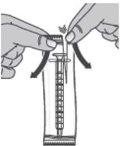
Figura B
- Se a seringa oral tiver um capuchão, retire-o e elimine-o para o lixo doméstico (ver Figura C).
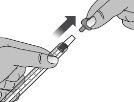
Figura C
A seringa tem marcas de dose no cilindro. Uma extremidade da seringa tem um cone de acoplamento que se insere no frasco do medicamento. A outra extremidade da seringa tem uma aleta de sujeição e um êmbolo que se utiliza para extrair o medicamento da seringa e administrá-lo (ver Figura D).
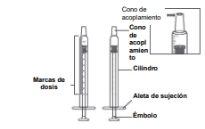
Figura D
1.3Empurre o êmbolo completamente para baixo para eliminar o ar da seringa (ver Figura E).

Figura E
1.4Certifique-se de retirar o fecho de segurança do frasco e insira o cone de acoplamento da seringa no frasco em posição vertical. O cone de acoplamento da seringa deve ficar bem ajustado no orifício do frasco

Figura F
1.5Uma vez colocada a seringa, gire o frasco para baixo (ver Figura G).
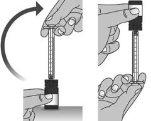
Figura G
1.6Para extrair uma dose do frasco, puxe lentamente o êmbolo para trás até que o êmbolo se alinhe com a marca do cilindro da seringa que coincide com a dose prescrita (ver Figura H). Há dois tipos de êmbolos que pode receber com a seringa: um êmbolo com o cone de acoplamento plano ou um êmbolo com o cone de acoplamento pontiagudo (ver Figura I abaixo do passo 1.6). Ver a Figura I para saber como alinhar o êmbolo com a dose prescrita. No caso do êmbolo com o cone de acoplamento plano, a extremidade plana do êmbolo deve alinhar-se com a marca do cilindro que coincide com a dose prescrita (Figura I.a.). No caso do êmbolo com o cone de acoplamento pontiagudo, certifique-se de que a parte plana e larga localizada abaixo do cone de acoplamento está alinhada com a marca correcta (Figura I.b.).
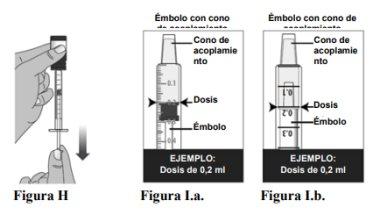
1.7Verifique a seringa por si houver bolhas de ar. Se observar bolhas de ar:
- Pressione o êmbolo para fazer passar as bolhas de ar de novo para o frasco (ver Figura J).
- A seguir, volte a extrair a dose prescrita seguindo as instruções do passo 1.6.
| |
Figura J.a. Verifique se há bolhas de ar | Figura J.b. Pressione o êmbolo na seringa para eliminar as bolhas de ar. |
1.8Uma vez extraída a dose correcta sem bolhas de ar, deixe a seringa no frasco e gire o frasco para cima (ver Figura K).
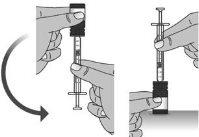
Figura K
1.9Retire a seringa do frasco com cuidado (ver Figura L). Para isso, segure o frasco firmemente com uma mão e a seringa pelo cilindro com a outra.
- Não pressione o êmbolo da seringa durante este passo.
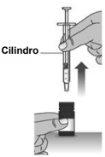
Figura L
Paso 2: Administração da dose
Nota:Si ou seu filho devem estar de pé enquanto tomam a dose e durante alguns minutos após.
2.1Insira o cone de acoplamento da seringa oral contra a parte interior da bochecha (ver Figura M).
Pressione lentamente o êmbolo até o fundo e despeje suavemente a solução oral na boca (ver Figura N).

FiguraMFigura N
2.2Certifique-se de que si/o seu filho engole a dose. Se não tiver certeza se engoliu toda a dose, não administre outra dose. Espere até que chegue a hora da próxima dose.
2.3Para fechar o frasco,volte a enroscar o fecho de segurança à prova de crianças no frasco girando-o para a direita (no sentido dos ponteiros do relógio) (ver Figura O).
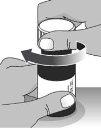
Figura O
2.4Retire o êmbolo do cilindro da seringa (ver Figura P) e lave-o com água após cada uso. Deixe secar o êmbolo ao ar antes de usá-lo novamente.
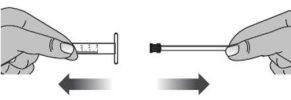
Figura P
- As seringas orais podem ser enxaguadas com água, deixadas secar ao ar e reutilizadas durante 130 dias.
Se tomar mais Livmarli do que deve
Informa o seu médico se tomar mais Livmarli do que deve.
Se esquecer de tomar Livmarli
Se esquecer de tomar uma dose, tome a próxima dose à hora habitual.
Se interromper o tratamento com Livmarli
Não interrompa o tratamento com Livmarli sem consultar antes o seu médico.
4. Possíveis efeitos adversos
Como todos os medicamentos, este medicamento pode produzir efeitos adversos, embora nem todas as pessoas os sofram. Podem produzir-se os seguintes efeitos adversos com este medicamento.
Muito frequentes(podem afectar mais de 1 em cada 10 pessoas)
- Diarreia
- Dor de estômago (abdominal) (SALG)
Frequentes(podem afectar até 1 em cada 10 pessoas)
- Dor de estômago (abdominal) (CIFP)
- Aumento das enzimas hepáticas (ALT, AST)
Estes efeitos adversos são geralmente leves ou moderados e podem melhorar durante o tratamento contínuo com Livmarli.
Se experimentar qualquer outro efeito adverso, ligue para o seu médico.
Comunicação de efeitos adversos
Se experimentar qualquer tipo de efeito adverso, consulte o seu médico, farmacêutico ou enfermeiro, mesmo que se trate de possíveis efeitos adversos que não aparecem neste prospecto. Também pode comunicá-los directamente através do sistema nacional de notificação incluído no Apêndice V. Mediante a comunicação de efeitos adversos, pode contribuir para fornecer mais informações sobre a segurança deste medicamento.
5. Conservação de Livmarli
Mantenha este medicamento fora da vista e do alcance das crianças.
Este medicamento não requer nenhuma temperatura especial de conservação. Conservar no embalagem original para protegê-lo da luz.
Não utilize este medicamento após a data de validade que aparece na caixa e no frasco após “CAD”. A data de validade é o último dia do mês que se indica.
Uma vez aberto o frasco, deve conservá-lo por baixo de 30 ºC e administrar o medicamento nos 130 dias seguintes à abertura. Transcorridos estes 130 dias, deve descartar o frasco, mesmo que não esteja vazio. Anote a data de abertura no frasco de Livmarli.
Os medicamentos não devem ser jogados pelos ralos nem na lixeira. Pergunte ao seu farmacêutico como se livrar dos envases e dos medicamentos que já não precisa. Dessa forma, ajudará a proteger o meio ambiente.
6. Conteúdo do envase e informação adicional
Composição de Livmarli
- O princípio ativo é maralixibato (na forma de cloreto).
- Cada ml de solução contém cloreto de maralixibato equivalente a 9,5 mg de maralixibato.
- Os outros componentes são propilenoglicol (E1520) (ver seção 2 “Livmarli contém propilenoglicol e sódio”), edetato dissódico (ver seção 2 “Livmarli contém propilenoglicol e sódio”), sucralose, aroma de uva e água purificada.
Aspecto do produto e conteúdo do envase
Livmarli é uma solução oral transparente e incolor a amarelo claro. É conservado em frascos de plástico de cor âmbar de 30 ml com um adaptador pré-instalado e um fecho de segurança à prova de crianças com um selo de espuma. Os 3 tamanhos de seringas orais (0,5 ml, 1 ml e 3 ml) fornecidos no envase são compatíveis com o adaptador pré-instalado e o tampão do frasco reutilizável. Para se certificar de administrar a dose correta de Livmarli, consulte a tabela da seção 3 (“Como tomar Livmarli”) a fim de selecionar o tamanho correto da seringa oral.
Tamanho do envase
1 frasco de 30 ml com 3 seringas orais (0,5 ml, 1 ml e 3 ml).
Título da autorização de comercialização
Mirum Pharmaceuticals International B.V.
Kingsfordweg 151
1043 GR Amesterdão,
Países Baixos
Responsável pela fabricação
Millmount Healthcare Limited
Block 7 City North Business Campus
Stamullen, Co. Meath, K32 YD60
Irlanda
Data da última revisão deste prospecto:
Este medicamento foi autorizado em «circunstâncias excepcionais». Esta modalidade de aprovação significa que devido à rareza desta doença não foi possível obter informações completas deste medicamento.
Outras fontes de informação
A informação detalhada deste medicamento está disponível na página web da Agência Europeia de Medicamentos: http://www.ema.europa.eu. Também existem links para outras páginas web sobre doenças raras e medicamentos órfãos.
- País de registo
- Substância ativa
- Requer receita médicaSim
- Fabricante
- Esta informação é apenas para referência e não constitui aconselhamento médico. Consulte sempre um médico antes de tomar qualquer medicamento. A Oladoctor não se responsabiliza por decisões médicas baseadas neste conteúdo.
- Alternativas a LIVMARLI 9,5 mg/mL SOLUÇÃO ORALForma farmacêutica: CÁPSULA, 1200 µgSubstância ativa: odevixibatFabricante: Ipsen PharmaRequer receita médicaForma farmacêutica: CÁPSULA, 200 µgSubstância ativa: odevixibatFabricante: Ipsen PharmaRequer receita médicaForma farmacêutica: CÁPSULA, 200 - REVISAR µgSubstância ativa: odevixibatFabricante: Ipsen PharmaRequer receita médica
Alternativas a LIVMARLI 9,5 mg/mL SOLUÇÃO ORAL noutros países
As melhores alternativas com o mesmo princípio ativo e efeito terapêutico.
Alternativa a LIVMARLI 9,5 mg/mL SOLUÇÃO ORAL em Ukraine
Médicos online para LIVMARLI 9,5 mg/mL SOLUÇÃO ORAL
Avaliação de posologia, efeitos secundários, interações, contraindicações e renovação da receita de LIVMARLI 9,5 mg/mL SOLUÇÃO ORAL – sujeita a avaliação médica e regras locais.















